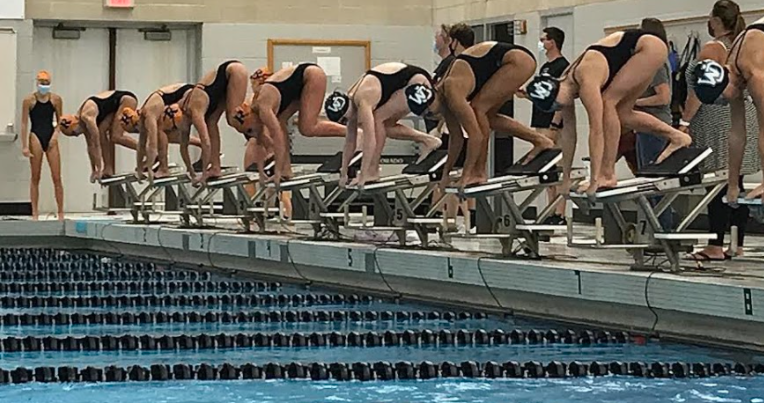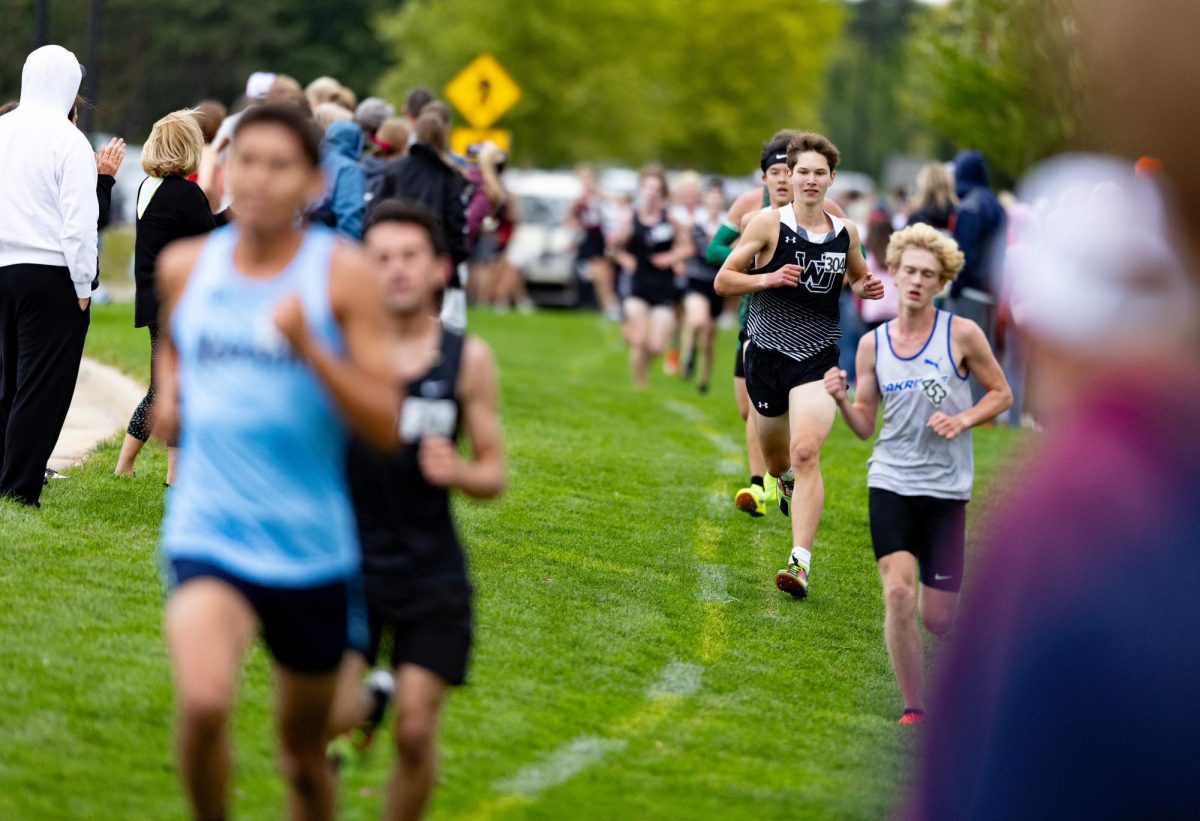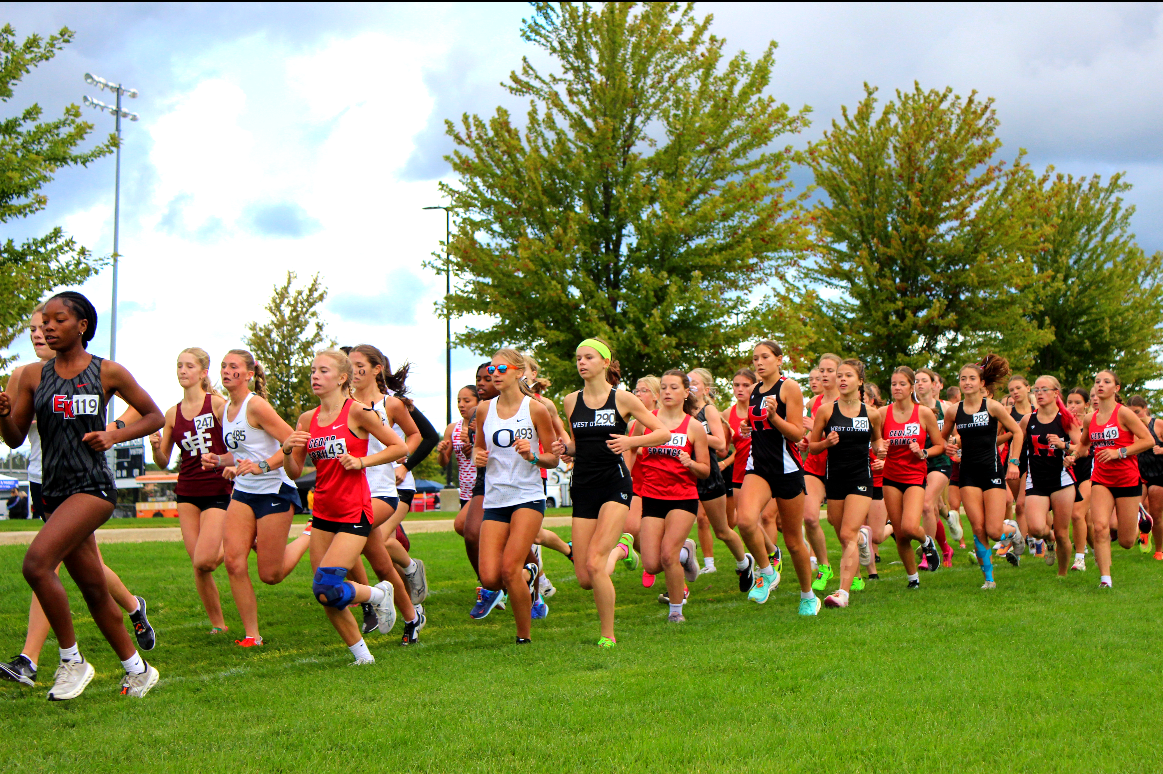High school swimmers today beat past American record times
October 7, 2020
A stillness fills the East Kentwood pool deck; all eyes are directed on the bulkhead where the final relay teams line up. “All I want for Christmas” blasts out of the loudspeakers and breaks the silence, signaling the line of swimmers to start their march around the pool.
The biggest moment of the 2019 season, the final swim of conference, is the 400-yard relay. The line of swimmers finish their trek and line up behind their blocks. The pool is quiet again. “Swimmers step up!”
As the swimmers mount the block, the tension in the room builds. “BEEP,” and they are off, the last race of the season. WOO!
The times achieved that night ranged from good to great; some times would have even beat American record times from 40-50 years ago. Clearly swimmers are getting faster. This burst of speed in the new generation of swimmers is easily explained by three main factors.
Decades ago, current WO Varsity swimmers would have been the fastest in the world. Their times rival fully-developed professional adult swimmers. For example, in 1976 Vickey Stanley swam the 50 yd free with a record time of 24.17 seconds. Her time is slower than West Ottawa Sr. Lilly Brandt’s personal record of 23.58 seconds.
Past World Record Times vs WO Varsity Swimmers’ Times


“It’s crazy how fast times are improving,” said Brandt, it makes her wonder how her times would compare if she swam in the past. She is correct, this fact is mind blowing. The world of swimming has changed so rapidly that young swimmers could have ranked up with the top athletes in the country only a few decades ago.
This reality is no random phenomenon. The three reasons for the increase in swimmer’s speed are that coaches have developed new techniques, the mental aspect of the sport has changed, and pools have literally gotten faster.
West Ottawa Swim Coach Steve Bowyer said that “there are a number of reasons,” as to why swimmers keep getting faster. Bowyer identifies improved training methods and schedules as the primary cause of the increasing speed.
He describes that since the start of his career in coaching there has been “more of an emphasis on speed rather than quantity. As well as resistance training to improve strength.”
Retired East Kentwood Swim Coach Jock Ambrose agrees. “When I started doing this thing 40+ years ago it was a lot of beating people to death and rest at the end, and hoping for the best. And I think now there is a much smarter way of preparing.”
Before scientists were able to study the body’s movements, many coaches believed that straight arms and limited time underwater was the key to fast swimming. “The coaches of the day were saying pull the arm straight through and those of us who were swimming slow were probably trying to do what our coaches said to. And those who were swimming fast were doing what was naturally just better for them [naturally bending their arm],” Ambrose said.
Over time, cameras and experimentation with a variety of strokes allowed coaches and scientists to improve swim techniques to help swimmers glide through the water more efficiently. “As science improves, you learn more about the physiology of the body, you know how people train, what they are doing in the water, and how much time they are devoting to the training,” Bowyer said.
Along with smarter methods of training, both coaches acknowledged that more swimmers have started to come into the high school season generally more prepared with prior coaching from USA and age group programs that practice year round.
Brandt explains her personal training schedule through Michigan Lakeshore Aquatics (MLA), one of the top USA programs in the area. “I pretty much train year round. When I am not in high school swimming, I swim for MLA which is pretty much the same training schedule without morning practice.”
Frosh. Oriana O’Mealy describes similar training. “Since I swim year round I do not get much of an off season but when I do get time off (for example during the COVID shut down) I swam in my own pool multiple times. I did a lot of mixed exercises like running and biking to the state park. I also spent a lot of time at a training facility called ETS performance athletes on cross fit and developing athleticism.”
With the added levels of training that generations of swimmers before did not have, building up speed is easier because swimmers are not starting over in terms of physical shape every season.
“If you have a swimmer who is in the water four months out of the year, unless they are extremely talented it is gonna be extremely hard to be as successful as other swimmers who are training year round, ” Bowyer states.
Another reason why swimmers keep getting faster is the psychological motivation built through increasingly challenging competition. Ambrose explains that he believes psychological elements play a big role in the evolution and motivation of the new generation of swimmers.
In practice, swimmers are taught and trained to push their limits to achieve goals that were thought to be unobtainable. “Nobody knows they can do something until they do it, and once they have done it, it is like ‘oh ok what’s next,’” Ambrose said.
This motivation carries swimmers through practices and important meets. Most swimmers enjoy the pressure because it pushes them to break new boundaries and records. Sr. Haley Menghini, explains, “I like doing it because I can push my limits in the pool. But it’s also a source of therapy. Sometimes it’s what gets me through my day,”.
While mostly helpful, sometimes the constant pressure to swim fast, make important relays, and support the team through points can occasionally get too much for our modern-day swimmers. Swimmers today have had to learn how to cope with the pressure, which can be extremely difficult.
Menghini talks about how she deals with lack of motivation and her mental state during the season. “Motivation is difficult for me, and something I never thought I’d struggle with. Swimming is a really grueling sport mentally and physically.” And sometimes when the pressure gets too much, taking a break is important. “I try to really give myself a break because mentally I need it at that point,” Menghini states.
The final reason for swimmers getting faster is technology. As technology use increased in daily life, scientists and coaches used said technology to analyze swimmers underwater. Something that had never been done before.
“I think that historically from 1955-1975 there was a huge understanding of those very things [position in the water and how the swimmer grips the water] we started seeing what people looked like underwater,” Ambrose recounts.
Prior to underwater cameras, coaches only could observe swimmers from above. Limiting their field of observation. Because scientists could see how the body moves underwater, new training and techniques were developed which helped swimmers to get faster.
Technology affected other aspects of swimming as well. One of the most noticeable being pools.
Many decades ago swimmers practiced in shallow pools. These pools were constructed to save money, because shallow pools cost less to construct and maintain. However, coaches and scientists found that swimming in deeper water was faster than shallow water.
“When we started to have to swim in at least 6.5 ft deep there was a big change in our sport,” Ambrose states, remembering his days as a swimmer and his early coaching years.
As well as being deeper, pool gutter systems, diving blocks, and bulkheads have all been modified to improve speed. Gutters have been made deeper so that water pushed into the gutter will not flood back into swimmers on the edge lanes. Some pools even have gutters that redistribute the water at the bottom of the pool. Helping cycle the water that is in the pool.
Bulkheads, which are narrow platforms that split up big pools into smaller sections, are designed with slats on the side. Allowing the water to rush through the side of the bulkhead to the other side of the pool instead of back at the swimmer when they make a flipturn.
Simply put by Bowyer, “pools have literally gotten faster.”
With all of these factors, it is not surprising that high school swimmers are crushing past American records. The odds are truly in their favor with the advancement of coaching methods, competitive pressure, and advancements in technology.




